2022.07.04.12
Files > Volume 7 > Vol 7 No 4 2022
Effect of adding natural zeolite and vitamin E to diets of laying hens ( Lohman Brown) on some physiological traits and productive performance during hot weather.
1 Department of Animal Production, College of Agriculture, University of Anbar, Anbar, Iraq; [email protected]
2 Department of Animal Production, College of Agriculture, University of Anbar, Anbar, Iraq;
* Correspondence: [email protected]; Tel.: (009647824445518).
Available from: http://dx.doi.org/10.21931/RB/2022.07.04.12
ABSTRACT
This study was conducted in a poultry farm of the Department of Animal Production / College of the Agriculture/University of Anbar, from 20/7/2021 to 12/10/2021, aiming to study the effect of adding zeolite to the diets on productive performance and some physiological qualities characteristics of laying hens. Seventy-two laying hens of Lohman Brown were used in this experiment at the age of 43 weeks and distributed randomly to six treatments with four replications (3 hens/ replicate). The birds were fed with the diet with the additives, and the treatments were as follows: T1 (Vit E 0.06), T2, T3, T4 and T5 with an addition of 0.25, 0.50, 0.75 and 1.0% relay, normal zeolite and T6 control treatment.
Results showed moral differences (P≤0.05) in the egg mass, the ratio of egg production and the number of cumulative eggs for T3, T4 and T5 treatments during the productive duration of the experiment.
Keywords: natural zeolites, productive performance, heat stress, laying hens.
INTRODUCTION
Eggs are considered an essential food item worldwide as they provide the human body with good quality proteins, fats, vitamins and minerals compared to other protein sources.
However, modern and intensive breeding has led to the emergence of many problems, including heat stress, which leads to oxidative stress as a result of high concentrations of Free radicals inside the bird's body which leads to weak resistance to diseases, deterioration of production, and then death. In the end, the production performance of hens is soft, so researchers must find solutions to these problems. Zeolite is one of the natural volcanic minerals that was formed after the eruption of lava millions of years ago. The basic building unit of the zeolite structure has a central atom of tetravalent silicon and trivalent aluminum. This leads to a negative charge on aluminum and silicon that is saturated with a positive ion. Replacing it with another positive ion, in this way, the zeolite acquires the well-known ion exchange property. It carries a negative charge consisting of hydrated aluminum silicate and alkaline earth elements. Silica, aluminum and oxygen are linked together to make the tetrahedra unit. The zeolite is light in weight and is brittle with a very light yellow or green hue 20. Many stressors impair the growth performance and health status of chickens. Redox homeostasis is the usual denominator of responses to these stresses that is maintained through a balance between the production of reactive oxygen species (ROS) and reactive nitrogen species and the antioxidant defense system. Oxidative stress results when ROS production exceeds the ability of the antioxidant defense system to remove these toxic molecules 13, 22. Several studies have shown that there is a significant difference in the presence of zeolite in the diet 5, the effect of zeolite improves digestion and intestinal absorption, which contributes to weight gain and the provision of feed use as well as reducing production costs 21 as well as noted 7 significant differences in production Eggs, average egg weight, egg mass, and the amount of feed consumed in the zeolite treatment compared to the control treatment, 16 indicated a positive effect of zeolite on the characteristics of production performance and eggshell quality. Therefore, the study aimed to show the impact of adding natural zeolite as an antioxidant on the productive performance of laying hens and some physiological characteristics.
MATERIALS AND METHODS
This study was conducted on the farm of the poultry Department of Animal Production/College of the Agriculture/University of Anbar from 20/7/2021 to 13/10/2021 to study the effect of adding zeolite to the diet on the productive performance and some physiological characteristics of laying hens. 72 hens were used in this experiment(Lohman Brown), 43 weeks old. They were randomly distributed to six treatments and four replicates per treatment (3 hens/replicate). The birds were fed a normal diet (Table 1) with supplements, and the treatments were as follows: T1(Vit E 0.06), T2, T3, T4 and T5 by adding 0.25, 0.50, 0.75 and 1.0% sequentially natural zeolite and T6 to the control treatment. At the same time, water was provided according to the water nipple system, and the illumination period was given to 15.5 hours per day. The percentage of egg production was calculated According to HD%, the average weight of eggs, feed consumed, the mass of eggs produced and provided conversion factor ( gm feed/gm egg ). The data were statistically analyzed using the statistical program for 4 to study the effect of different treatments on the traits studied in the experiment according to a completely randomized design ( CRD) and comparison of significant differences between means with Duncan's polynomial test 16.
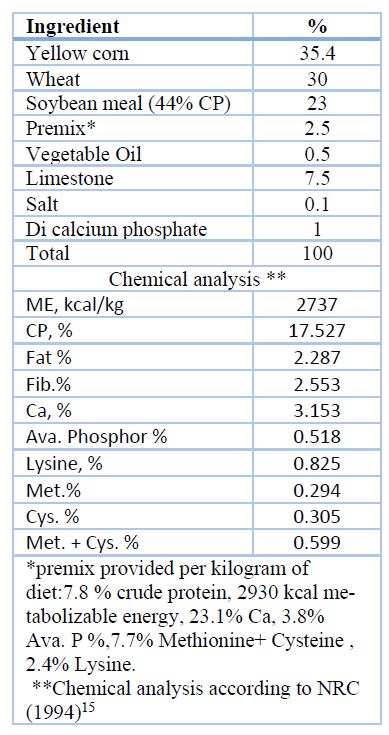
Table 1. Shows the components of the ratio used in the experiment
RESULTS AND DISCUSSION
Productive traits
Table 2 showed no significant differences (P<0.05) in the average egg weight for the total production period when different levels of zeolite and vitamin E were added to the laying hens' diets. It is also noted from the table that there are significant (P<0.05) differences between the experimental treatments in the mass of eggs produced for the total period, where the treatments T3, T4 and T5 were significantly (P<0.05) superior compared to the rest of the experimental treatments. The table also shows a significant superiority (P<0.05) for the T5 addiction treatment (1% zeolite) in the percentage of egg production on the remaining experimental treatments compared to the control treatment, and we notice a significant superiority (P<0.05) for the T5 addiction treatment over the rest of the experimental treatments during the productive period. In the cumulative number of eggs compared to the control treatment T6, We also note from the same table that there is a significant improvement for the treatment T5 (1% natural zeolite) compared with T2 and T6 in the feed conversion factor. These results are in agreement with findings 1; 9; 11. The results of the experiment did not agree with the findings of 18 and 8, which indicated no significant differences when adding zeolite to laying hens' diets. It played an indirectly effective role in preserving liver cells from oxidative damage caused by heat stress 7. Zeolite improves digestion and intestinal absorption, which contributes to saving the use of feed, as well as reducing production costs 6. The discrepancy in the content of these effective vehicle transactions and their influence is in restraining free radicals, increasing antioxidant activity in the body, inhibiting lipid peroxidation and reducing oxidative stimuli. Antioxidants work to perpetuate the raw materials needed for the growth of ovarian follicles, most of which are fatty substances.
The role of treatments as antioxidants in poultry diets works to protect lipoproteins and fatty compounds. The other substances enter into the yolk formation from oxidation, which leads to an abundance of these substances, and then the maturation of the ovarian follicles in a shorter time than those in chickens that did not take levels of antioxidants in the diet. The role of antioxidants is to reduce the formation of free radicals and protect the membranes. Thus, the cells have preserved them from exposure to harmful damage due to free radicals, protecting lipoproteins from breakdown, regulating the representation of body fats and encouraging the deposition of materials necessary for ovarian follicle growth. Thus the cells continue to carry out vital activities, which results in higher production performance and quality improvement. 3;12;14.
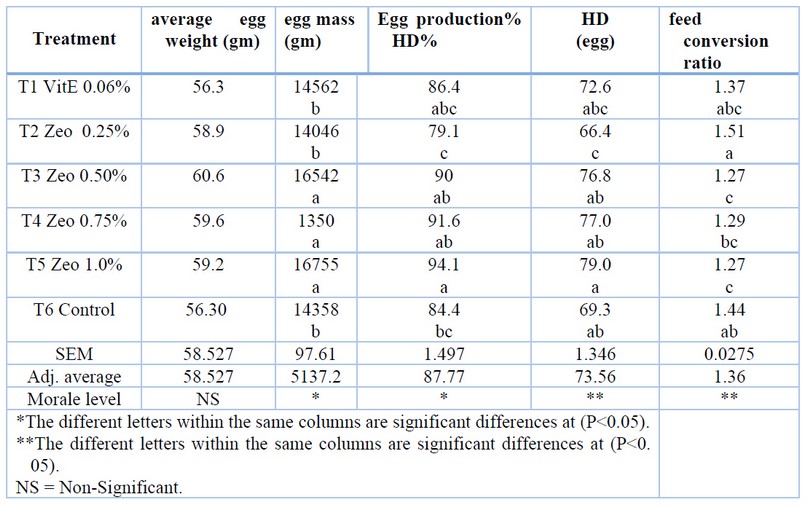
Table 2. Effect of adding different levels of Natural Zeolite and vitamin E to the diets Of laying hens (Lohman Brown) on productive performance of laying hens.
Blood traits
Measurement of PCV
The results are illustrated in Figure 1. There are statistically significant differences between the experimental treatments for cellular blood traits at the end of the experimental period. We note the superiority of the T6 control treatment in the volume of compressed blood cells, which amounted to 30.1% over the rest of the additional treatments.
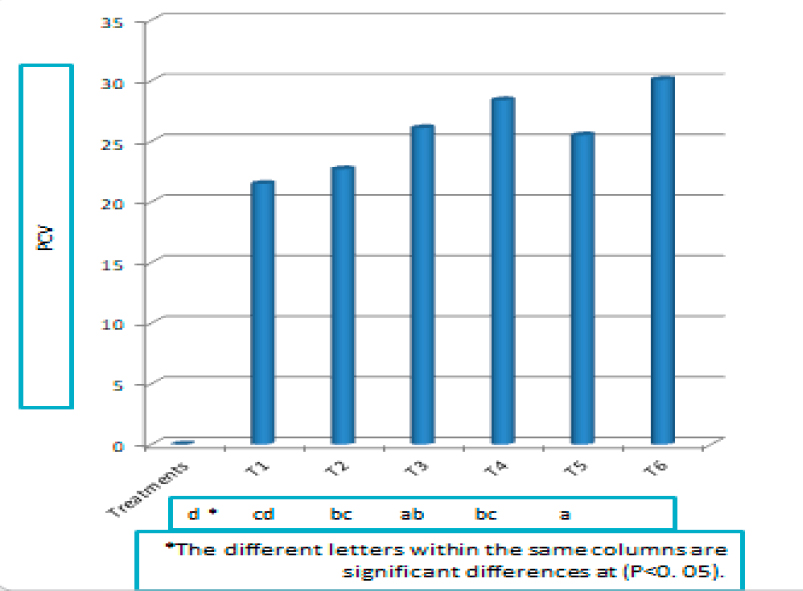
Figure 1 . Effect of adding different levels of natural zeolite and vitamin E to the diets of laying hens (Lohman Brown) on the volume of packed blood cells.
L/H . ratio
We notice from Figure 2. A significant decrease (P<0.05) in treatment T1, T2, T3 and T5 compared to treatment T4 and control treatment T6 in the ratio of heterophil to lymphocytes LH-1 . The reason for the superiority of the additional treatments may be due to the variation in the content of these treatments from the active compounds and their effect in reducing the impact of heat stress through restricting free radicals, increasing the activity of antioxidants in the body, inhibiting lipid peroxidation and reducing oxidation catalysts 12.
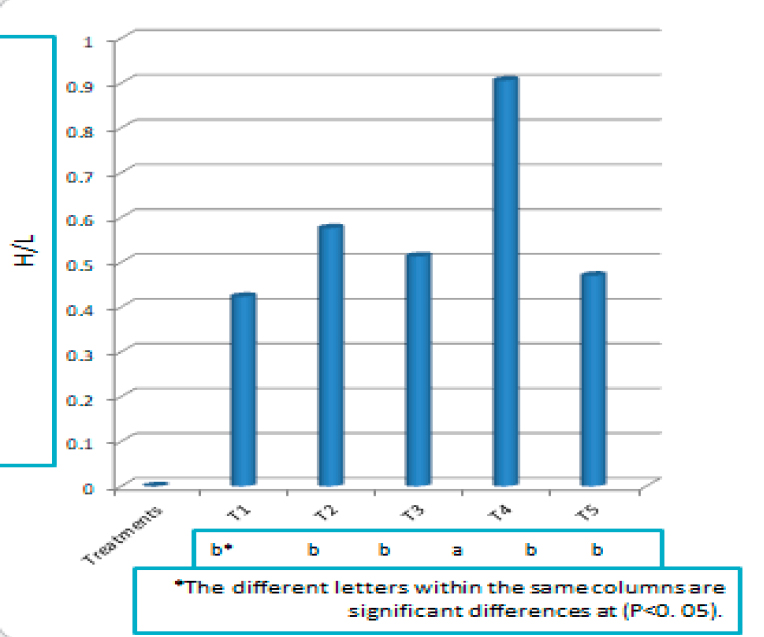
Figure 2. A significant decrease (P<0.05) in treatment T1, T2, T3 and T5 compared to treatment T4 and control treatment T6 in the ratio of heterophil to lymphocytes
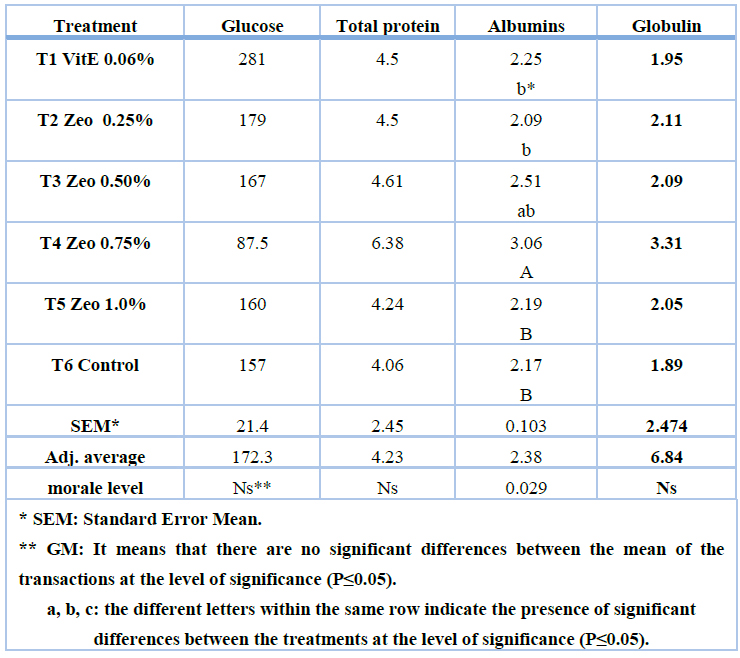
Table 3. The effect of adding different levels of natural zeolite and vitamin E to the diets of laying hens (Lohman Brown) on blood biochemical characteristics (HD) during the productive period (43-54) weeks (20/7/2021-13). 10/2021)
Glucose and blood proteins
The results of Table 3. indicated that there were no significant differences (P<0.05) between the experimental treatments at the end of the total experimental period, as the table shows that there was no significant difference in the concentrations of (glucose, total protein and globulin) for all the different experimental treatments. These results agreed with what was reached by 2;5;10;17, who indicated no significant differences when adding zeolite to chicken diets. The results of the statistical analysis in the same table showed that there was a significant (P<0.05) superiority for the T4 supplement (0.75% natural zeolite) treatment in the serum albumin concentration, which did not differ significantly from the T3 supplement (0.5% natural zeolite) treatment compared to the rest of the experimental treatments. These results agreed with the findings 17. Albumin is the main part of the total protein in the blood. It is manufactured by the liver and is considered an indicator of the liver's ability to produce proteins. Low albumin is evidence that the liver's manufacturing function has decreased as a result of damage to liver tissues and cells. As for globulin, which includes antibodies present in blood plasma, it is considered an indicator of immunity and gives evidence of the extent of liver tissue damage. 13 Therefore, the T4 addition treatment showed a significant improvement in liver function during hot weather, followed by the T3 treatment, which did not differ significantly from T4.
CONCLUSIONS
We conclude from this study that adding zeolite to laying hens' diets at a rate of 1% led to an increase in egg production, egg mass and a decrease in the feed conversion ratio (gm of feed/gm of eggs).
REFERENCES
1. Al-Bayati, Sabah Khurshid Shakur, Effect of adding Climix and Mycofix to laying hens' diets containing two sources of yellow corn on some productive and physiological traits. PhD thesis, College of Agriculture - Tikrit University2018.
2. Demirel, R. ; B. Yokus, ; D.E. Demirel, ; M.A. Ketani, and Baran, M.S . Effects of Dietary Zeolite on Serum Contents and Feeding Performance in Rats. International Journal of Agriculture & Biology, 2011. 13(3).
3. de-Oliveira Garcia, S., Sibaja, K. V. M., Nogueira, W. V., Feltrin, A. C. P., Pinheiro, D. F. A., Cerqueira, M. B. R., and GardaBuffon, J. Peroxidase as a simultaneous degradation agent of ochratoxin A and zearalenone applied to model solution and beer. Food Research International. 2020.
4. Duncan, D.B. Multiple range and Multiple F test. Biometrics. 1955. 11: 1 9– 42
5. Eleroğlu, H. ; H. Yalçın, and Yıldırım, A . Dietary effects of Cazeolite supplementation on some blood and tibial bone characteristics of broilers. South African Journal of Animal Science, 2011. 41(4): 319-330.
6. Eleroğlu, H., & Yalçın, H. Use of natural zeolite-supplemented litter increased broiler production. South African Journal of Animal Science, 2005. 35(2), 90-97.
7. Gul , H., Khan, S., Shah, Z., Ahmad, S., Israr, M., and Hussain, M . Effects of local sodium bentonite as aflatoxin binder and its effects on production performance of laying hens. Kafkas Üniversitesi Veteriner Fakültesi Dergisi, 2017.23(1), 31-37.
8. Kermanshahi, H., Jani, E. H. A., Hashemipour, H., & Pilevar, M. Efficacy of natural zeolite and pigments on yolk color and performance of laying hens. African Journal of Biotechnology, 2011. 10(16), 3237-3242.
9. Khambualai, O., M. Ruttanavut, H. Kitabatake, H. Goto, T. Erikawa, and K. Yamauchi. Effects dietary natural zeolite including plant extract on growth performance and intestinal histology in Aigamo ducks. Br. Poult. Sci. 2009. 9:123–128.
10. Kubena, L.F. ; W.E Huff, ; R.B. Harvey, ; AG Yersin, ; M.H Elissalde, ; A.D. Witzel, and Petersen, H.D . Effects of a hydrated sodium calcium aluminosilicate on growing turkey poults during aflatoxicosis. Poultry Science, 1991. 70(8): 1823-1830.
11. Macháček, M., Večerek, V., Mas, N., Suchý, P., Straková, E., Šerman, V., & Herzig, I. Effect of the feed additive clinoptilolite (ZeoFeed) on nutrient metabolism and production performance of laying hens. Acta Veterinaria Brno, 2010. 79(9), 29-34.
12. Mohammed Th T, AL-Khalani FMH and ALDhanki ZTM. Comparison effect of adding artificial and natural antioxidant on performance, physiological traits, antioxidant status and eggs quality of brown laying hens. Al-Anbar Journal of Agricultural Sciences.2013b.
13. Mohammed Th. T., Farhan SM1, Majid A.A., Mohammed Saeid ZJ & Abdulateef F.M.Effect of vitamin C and natural antioxidants on the production performance and antioxidant status of laying hens through heat . Journal. Research. in Ecology.(2018a). 6 ,( 2), 2364-2375.
14. Mohammed. Thafer Thabit.The effect of adding different levels of artificial antioxidants and natural antioxidants in the diet on production and physiological performance in laying hens . PhD thesis, College of Agriculture, University of Anbar. 2012.
15. N. R. C., National Research Council. Nutrient Requirements of Poultry. 9th ed., National Academic Press, Washington, DC., USA. 1994. P. 120.
16. Olver, M. D. Effect of feeding clinoptilolite (zeolite) to three strains of laying hens. British poultry science, 1989. 30(1), 115-121.
17. . Safaeikatouli, M. ; Y. Jafariahangari, and Baharlouei, A . An evaluation on the effects of dietary kaolin and zeolite on broilers blood parameters, T4, TSH and growth hormones. Pakistan Journal of Nutrition, 2011 .10(3): 233-237.
18. Samara, M. Effect of Feeding Natural Zeolite on Performance of Laying Hens Drinking Saline Wate.2003.
19. SAS J. Statistical Analysis System, v. 10.0. 2. Cary, North Carolina USA. 2012.
20. Sean, D. and I.Yoshio .. Zeolites. Chemical Economics Handbook, SRI Consulting. 2009.
21. Shariatmadari, F. The application of zeolite in poultry production. Worlds Poult. Sci. J. 2008. 64:76–84.
22. Wu, Y., Wu, Q., Zhou, Y., Ahmad, H., & Wang, T. Effects of clinoptilolite on growth performance and antioxidant status in broilers. Biological Trace Element Research, 2013.155(2), 228-235.
Received: 20 July 2022 / Accepted: 15 October 2022 / Published:15 November 2022
Citation: E H H Alsalmany, Mohammed T H T. Effect of adding natural zeolite and vitamin E to diets of laying hens ( Lohman Brown) on some physiological traits and productive performance during hot weather. Revis Bionatura 2022;7(4) 12. http://dx.doi.org/10.21931/RB/2022.07.04.12
